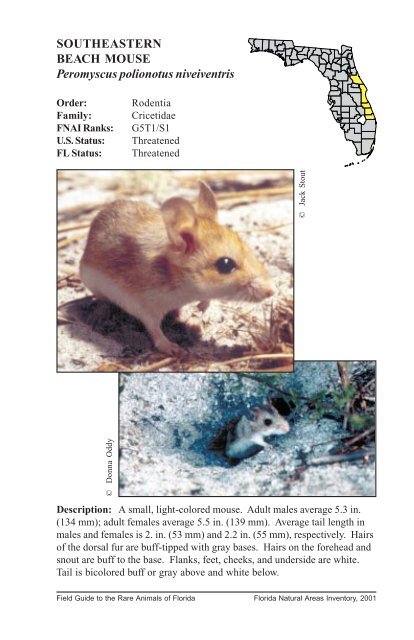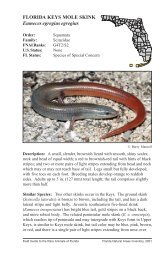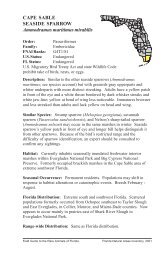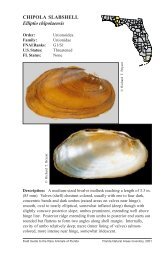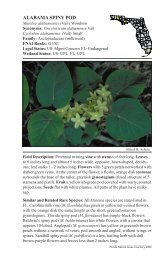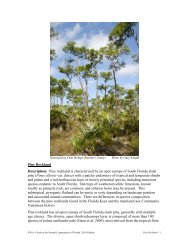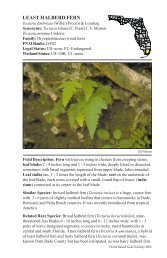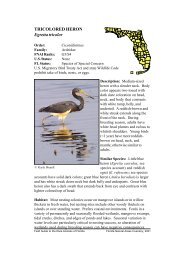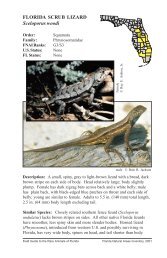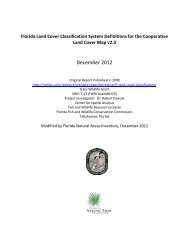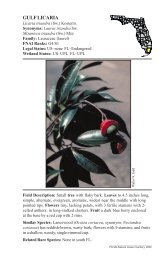Peromyscus polionotus niveiventris - Florida Natural Areas Inventory
Peromyscus polionotus niveiventris - Florida Natural Areas Inventory
Peromyscus polionotus niveiventris - Florida Natural Areas Inventory
You also want an ePaper? Increase the reach of your titles
YUMPU automatically turns print PDFs into web optimized ePapers that Google loves.
SOUTHEASTERN<br />
BEACH MOUSE<br />
<strong>Peromyscus</strong> <strong>polionotus</strong> <strong>niveiventris</strong><br />
Order:<br />
Family:<br />
FNAI Ranks:<br />
U.S. Status:<br />
FL Status:<br />
Rodentia<br />
Cricetidae<br />
G5T1/S1<br />
Threatened<br />
Threatened<br />
© Donna Oddy<br />
© Jack Stout<br />
Description: A small, light-colored mouse. Adult males average 5.3 in.<br />
(134 mm); adult females average 5.5 in. (139 mm). Average tail length in<br />
males and females is 2. in. (53 mm) and 2.2 in. (55 mm), respectively. Hairs<br />
of the dorsal fur are buff-tipped with gray bases. Hairs on the forehead and<br />
snout are buff to the base. Flanks, feet, cheeks, and underside are white.<br />
Tail is bicolored buff or gray above and white below.<br />
Field Guide to the Rare Animals of <strong>Florida</strong> <strong>Florida</strong> <strong>Natural</strong> <strong>Areas</strong> <strong>Inventory</strong>, 2001
SOUTHEASTERN<br />
BEACH MOUSE<br />
<strong>Peromyscus</strong> <strong>polionotus</strong> <strong>niveiventris</strong><br />
Similar Species: Other subspecies of beach mouse (oldfield mouse) are<br />
similar in appearance, but do not overlap in range. Cotton mouse<br />
(<strong>Peromyscus</strong> gossypinus) is larger (5.6 - 8.1 in. = 142 - 206 mm), has a<br />
relatively longer tail (2.7 - 4.5 in. = 71 - 116 mm), and is chestnut-brown<br />
and gray. <strong>Florida</strong> mouse (Podomys floridanus) is also larger (7.3 - 8.0 in. =<br />
179 - 203 mm) and similar in color to cotton mouse; hind feet generally<br />
have five large pads (plantar tubercles) versus six to seven (rarely five)<br />
small pads of beach mice and other <strong>Peromyscus</strong> species. House mouse (Mus<br />
musculus) is gray above with a slightly lighter gray underside and has a<br />
hairless, nearly unicolor (gray-pink) tail that is generally longer than 2.5 in.<br />
(63 mm).<br />
Habitat: Primary, secondary, and occasionally tertiary sand dunes with a<br />
moderate cover of grasses and forbs, including sea oats (Uniola<br />
paniculata), bitter panicum (Panicum amarum), and beach dropseed<br />
(Sporobolus virginicus). Adjacent coastal palmetto flats (coastal strand)<br />
and scrub are important during and following hurricanes.<br />
Seasonal Occurrence: Less active when the moon is bright.<br />
<strong>Florida</strong> Distribution: Historically occurred from New Smyrna Beach<br />
possibly as far south as Miami Beach. Now known from a few isolated<br />
locations from southern Volusia County to Martin County.<br />
Range-wide Distribution: Same as <strong>Florida</strong> distribution. Southeastern<br />
beach mouse is a subspecies of oldfield mouse, which is common<br />
throughout Alabama, Georgia, southern South Carolina, and most of<br />
<strong>Florida</strong>.<br />
Conservation Status: The extensive habitat at Cape Canaveral Air Station<br />
and Canaveral National Seashore provide a stronghold for the southeastern<br />
beach mouse. Small tracts of suitable habitat exist south of Brevard<br />
County; however, long-term survival at these sites is unlikely without<br />
population augmentation.<br />
Protection and Management: Prevent damage to dune habitat: construct<br />
boardwalks over dunes; prevent off-road-vehicle (ORV) use on dunes;<br />
restore breaks in the primary dune to prevent erosion and flooding during<br />
high tides and surges. Remove feral cats, which are thought to cause high<br />
mortality.<br />
Selected References: Brown 1997, Humphrey (ed.) 1992, Whitaker 1996.<br />
Field Guide to the Rare Animals of <strong>Florida</strong> <strong>Florida</strong> <strong>Natural</strong> <strong>Areas</strong> <strong>Inventory</strong>, 2001


